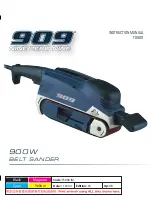
OPERATION INSTRUCTIONS
Warning! Before using your sander be
sure to read the instruction manual
carefully.
1. FITTING THE SANDING PAPER
(See Fig2)
(a)Make sure the plug is disconnected from the
mains supply.
(b)Align the dust extraction holes in the sanding
pad with the holes in the base and press firmly
together (see fig2).
(c)Spare sanding sheets can be purchased from
any good DIY store.
Warning! Always switch off and unplug
from the mains before making any
adjustment.
2. SWITCHING ON AND OFF
(See Fig3a & 3b)
To operate the detail sander,put the plug into
mains supply(make sure On/Off switch is in Off
position see fig3a), grip sander firmly with both
hands and switch on (see fig3b). At all times, let
the sander do the work - do not force it or apply
excessive pressure, otherwise damage may
occur to the abrasive paper causing it to tear or
wrinkle. Preferably, use a light circular motion.
The sander can also be used on slightly curved
surfaces, owing to the rubber-made base plate.
The shaped base plate can be used to access
awkward corners / areas.
3. VARIABLE SPEED CONTROL
(See Fig4)
According to the material to be sanded and
sanding paper specification, you can adjust
sanding speed by turning the speed selector
wheel. The greater speed is indicated by the
higher figure. The little speed is indicated by the
lower figure.
4. USING THE SANDER
(See Fig5)
Note:
If you see some sparks flashing in the
ventilation slots do not panic, this is normal and
will not damage the tool.
Be sure to hold the sander firmly whilst it is on
and apply it gently to the work; it may kick on first
contact. Hold the sander so that it is flat on the
work and move slowly, preferably in parallel line
movements. When you first turn it on, make sure
that your finger remains on the switch so you can
STOP the sander in case there is a problem.
Fig 3a
Fig 3b
Fig 2
Fig 4
Summary of Contents for SF280E
Page 1: ...280W DETAIL SANDER SF280E SAFETY AND OPERATING MANUAL...
Page 13: ......































